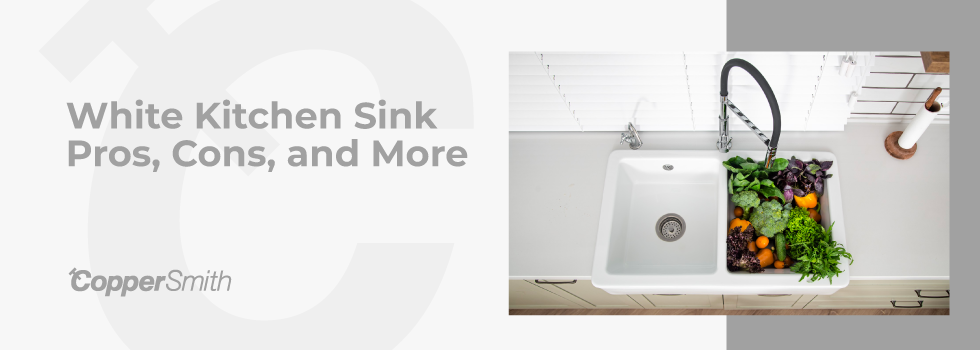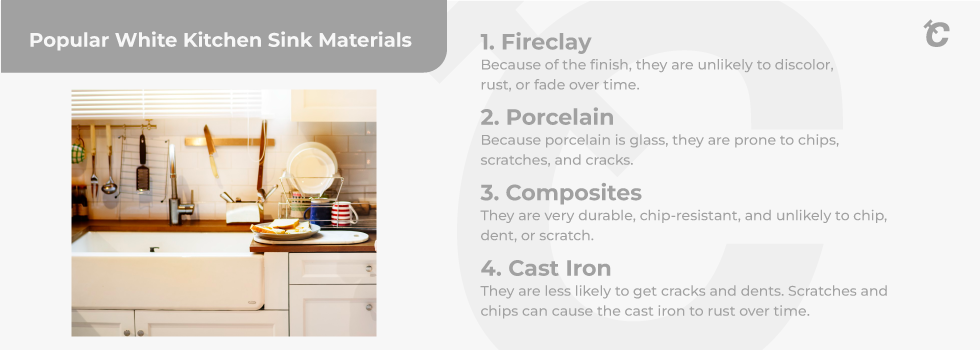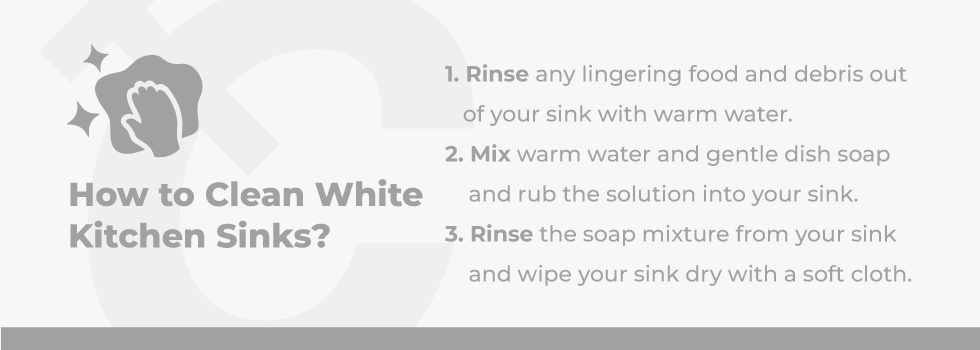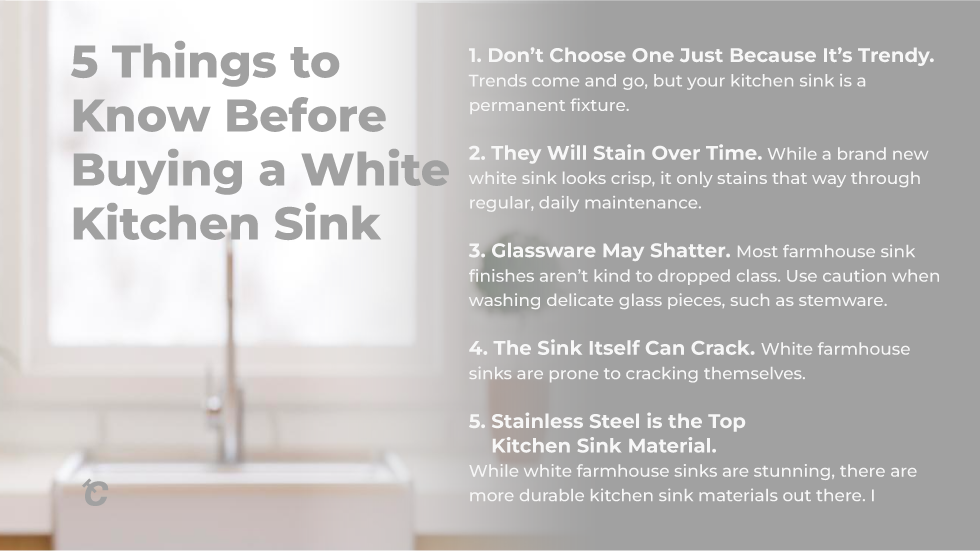
Learn about the best white kitchen sink materials, how to keep your white sink clean, and what to know when choosing a sink.
White is the second most popular kitchen sink color for upcoming years. Homeowners love them because they’re light, bright, and airy. From quartz to wood and marble to granite, white sinks complement many different types of countertops.
And if you’re envisioning a white kitchen sink for your home, here’s what to know about the white farmhouse sink trend, white kitchen sink materials, cleaning tips, and more.
What’s the White Farmhouse Kitchen Sink Trend?
White kitchen sinks are a key part of the all-white kitchen and farmhouse trends. Farmhouse-inspired sinks are one of the most popular white sink styles, and they’re now available in an array of modern materials. The National Kitchen and Bath Association (NKBA) reports that 45% of their survey participants say that farmhouse and apron sinks are the second most popular kitchen sink style.
White farmhouse sinks are very popular, especially in remodeled homes. These sinks are much deeper and wider than traditional kitchen sinks, and busy households love them because of their size and functionality. Though, we should note that white farmhouse sinks are challenging to install. If you want to add a farmhouse sink in your kitchen, oftentimes the surrounding counters need to be redone to fit the sink.
Another drawback about white farmhouse sinks is there’s no countertop between the sink and the edge. So, you might get splashed with water if you’re washing the dishes. The water can also splash on the cabinets below, which can cause damage if it’s not wiped away.
But don’t let the downsides discourage you from choosing a white farmhouse sink. With proper installation, they’re a stunning kitchen addition. On average, a new farmhouse sink cost between $1,000 and $4,000 with installation.
Popular White Kitchen Sink Materials

White kitchen sinks are made in a variety of materials, including fireclay, porcelain, granite composite, and cast iron. Choose from single basins, double basins, undermounts, drop-ins, and farmhouse sinks. They all come in a variety of configurations. Here’s an overview of the pros and cons for each:
Fireclay
Fireclay sinks are made out of a mixture of clay and glaze that’s fired at extremely high temperatures. Then, the sink is glazed to create a non-porous material. This process creates a very durable, modern material that’s very similar to cast iron sinks. Fireclay kitchen sinks are available in an array of colors, including white, cream, black, gray, brown, and more.
- Cost - Fireclay kitchen sinks can cost anywhere between $400 and $3,000.
- Finish options - Most fireclay sinks are available in glossy and matte finishes.
- Durability - It’s nearly impossible to scratch or chip fireclay, and they’re much less likely to crack or scratch compared to cast iron. Because of the finish, fireclay sinks are unlikely to discolor, rust, or fade over time.
- Stains - Fireclay sinks are resistant to stains, but you may notice white water spots or greasy stains. Regular maintenance and cleaning will help remove these stains.
- Maintenance - Fireclay kitchen sinks are easy to maintain. Regularly clean your sink with warm water, dish soap, and baking soda to keep it clean. You can also wax your fireclay sink once a month to keep it shining.
Porcelain
Porcelain kitchen sinks are made out of heavy-duty ceramic, which is made in a range of shapes and colors. But white porcelain sinks are the most common. Porcelain is resistant to extreme hot and cold temperatures, but it can be chipped, scratched, or cracked by heavy objects.
- Cost - In general, porcelain kitchen sinks cost between $90 and $1,500 to purchase and install. Porcelain sinks are very heavy, and this makes installation more challenging.
- Finish options - Porcelain kitchen sinks are known for their white, glossy finish.
- Durability - Because porcelain is glass, porcelain sinks are prone to chips, scratches, and cracks. Cast iron sinks that are covered in porcelain offer more strength than porcelain alone. You’ll want to be careful when cleaning heavy pots and pans to prevent dropping them on your porcelain sink.
- Stains - Porcelain tends to stain more easily than other materials. It’s important to always rinse out any food or water that’s poured down the drain to prevent staining.
- Maintenance - Porcelain is a very low-maintenance material. To keep it in tip-top shape, regularly clean the sink with warm water and soap. Never use abrasive cleaners and tools on your porcelain sink that could accidentally scratch the surface.
What’s the Difference Between Ceramic and Porcelain Sinks?
Ceramic and porcelain are both a type of pottery. Both of these sinks look very similar in appearance, but porcelain sinks are stronger and more durable than ceramic sinks. Ceramic sinks are unable to withstand a heavy impact, so they’re not recommended for kitchens. Porcelain sinks are much more scratch- and chip-resistant than ceramic, so they’re a better choice for kitchen sinks.
Composites
Composite kitchen sinks are typically made out of granite or quartz. They’re mixed with other plastics and resins to create a highly-durable, non-porous engineered sink material. Similar to fireclay, they’re available in a range of colors, such as white, cream, brown, black, gray, blue, and more.
- Cost - Composite sinks are relatively affordable and range between $300 and $600.
- Finish options - Granite and quartz composite sinks are made in matte finishes.
- Durability - Composite kitchen sinks are very durable and chip-resistant. They’re unlikely to chip, dent, or scratch. Scratches are likely to show on darker surfaces more than on light-colored options. These sinks are heat-resistant, though they may warp from extreme heat.
- Stains - These kitchen sinks are highly stain-resistant. Though, white granite composite sinks are more likely to stain than darker colors. To remove staining, soak the sink with a 50/50 solution of hot water and vinegar.
- Maintenance - Composite kitchen sinks are easy to keep clean. Most only require dish soap, water, and a soft sponge to keep clean. Never use abrasive cleaners or drain cleaners as these could damage the sink.
Cast Iron
Cast iron kitchen sinks are incredibly long-lasting and can handle heavy use for years. Most of these sinks have a cast iron base with a porcelain enamel coating. The coating protects the base cast iron and provides a smooth, glossy finish. Most cast iron sinks are white, but they’re made in other colors as well.
- Cost - Cast iron sinks usually run between $300 to $900.
- Finish options - Cast iron is typically finished with hard porcelain enamel in a glossy finish.
- Durability - Cast iron kitchen sinks are prone to scratches and chips. Though, they’re less likely to get cracks and dents. It’s important to know that scratches and chips can cause the cast iron to rust over time.
- Stains - Over time, the white enameled surface can stain, but it shouldn’t stain easily. Always rinse your sink out after preparation and washing dishes to prevent stains.
- Maintenance - Cast iron kitchen sinks are easy to maintain. To clean, wash the sink with warm water and dish soap, then the sink dry after you rinse it out. Avoid abrasive cleaning objects as these can scratch the surface of the sink.
How to Clean White Kitchen Sinks

Most white kitchen sinks can be cleaned with warm water, gentle dish soap, and a soft sponge or cloth. Follow these steps to keep your white kitchen sink sparkling:
- First, rinse any lingering food and debris out of your sink with warm water.
- Then, mix warm water and gentle dish soap and rub the solution into your sink.
- Rinse the soap mixture from your sink and wipe your sink dry with a soft cloth.
If your white kitchen sink has stubborn stains or dried food, create a paste with baking soda and water. Then, rub the paste into the stained area, rinse and repeat. Always check your sink’s manufacturer before using any new cleaning to prevent damage.
No matter what type of white kitchen sink you have, never use the following:
- Abrasive tools like steel wool
- Bleach or strong acids
5 Things to Know Before Buying a White Kitchen Sink

Here are five things to consider before purchasing a white kitchen sink for your home.
1. Don’t Choose One Just Because It’s Trendy
Trends come and go, but your kitchen sink is a permanent fixture. While white kitchen sinks, especially farmhouse sinks are trending, don’t install one in your kitchen just because they’re all you see on Pinterest.
MyMove interviewed John Manning, Manager Broker RE/MAX On Market in Seattle, “Farmhouse sinks are popular – especially if they are part of a holistic design scheme, but it would not be to the seller’s advantage to installing a farmhouse sink — or any trendy sink for that matter — in a classic Craftsman or Victorian home, looking like a random afterthought.”
2. They Will Stain Over Time
White farmhouse sinks can be tricky to keep clean. And while a brand new white sink looks crisp, it only stains that way through regular, daily maintenance. White cast iron and porcelain sinks tend to show the most wear-and-tear compared to newer engineered materials like fireclay and composites. Most light stains can be removed with baking soda.
3. Glassware May Shatter
Have you ever accidentally dropped a dish or cup in the sink? If you have a white farmhouse sink, you’ll need to be very careful. These sinks are designed for washing large pots and pans. But when you’re cleaning your favorite dishware in soapy water, it’s easy to accidentally drop a plate. And most farmhouse sink finishes aren’t kind to dropped class. Use caution when washing delicate glass pieces, such as stemware.
4. The Sink Itself Can Crack
White farmhouse sinks are prone to cracking themselves. To protect your white sink from scratches and cracks, never drop heavy pots or pans in the sink. Always use caution when placing sharp objects, such as knives, in the sink basin to prevent scratching.
5. Stainless Steel is the Top Kitchen Sink Material
While white farmhouse sinks are stunning, there are more durable kitchen sink materials out there. If you’re concerned about cracks and stains, a stainless steel kitchen sink may be a better choice for your household. Stainless steel sinks are also one of the easiest sinks to keep clean. Though stainless steel sinks aren’t better than white sinks. The best sink option for your kitchen depends on your kitchen remodel costs, household, and how often you use your kitchen.
Design Your Dream Kitchen with CopperSmith
Are you looking for a luxurious kitchen sink for your upcoming remodel? Contact our team at CopperSmith to learn about our sustainable, high-end sinks. While we don’t specialize in white sinks, we are known for our durable stainless steel, brass, and copper masterpieces.
Or, if you need a high-end faucet for your new farmhouse sink, browse our assortment of sink accessories.
